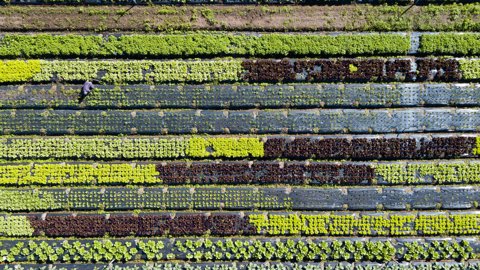Investments in agriculture and forestry are part of APG’s diversified investment portfolio. How do investors handle the climate risks inherently tied to this asset class? Olav Houben, Expert Portfolio Manager for Private Natural Capital, discusses the challenges and how certain risks can be mitigated. “We need to determine if our activities in some areas will still be profitable in the future.”
In a nutshell:
• APG, on behalf of its pension fund clients, manages a portfolio of agricultural and forestry investments worth €3 billion in Europe, North and South America, and the Asia-Pacific region.
• Regenerative farming breaks with the tradition of intensive use of fertilizers and pesticides in agriculture.
• The use of genetically modified crops and the changing diet of people can greatly influence the future of farming.
At APG, a team of eight colleagues, based in offices in Amsterdam, New York, and Hong Kong, handles investments in agriculture and forestry in Europe, North and South America, and the Asia-Pacific region. They manage a portfolio worth €3 billion, evenly divided between agricultural and forestry investments. These investments are managed sustainably. What is new is that ABP, the pension fund client committing capital to APG’s strategy, has changed the existing mandate to impact investments in agriculture and forestry. Houben explains: “This means we must be intentional and pursue positive outcomes within our investments. While there are several impact areas we can look at, we believe Private Natural Capital (PNC) is well positioned to achieve positive outcomes in climate and biodiversity—two themes that are a priority for ABP.”
Impact investments and regenerative agriculture
Regenerative agriculture does play a role in APG’s impact investment strategy. The concept entails a shift from conventional agriculture and is generally described by a set of holistic farming practices, aimed at working in harmony with nature while improving the economic conditions of farmers. Two things are important in this transition, says Houben. “Firstly, it must be profitable for the farmer to embark on such a path. When transitioning to regenerative agriculture, there’s always a J-curve. As a farmer, you take a risk because you’re deviating from the conventional approach, such as reducing the use of fertilizers, pesticides, and herbicides. The expectation is that the yield per hectare will eventually be the same as before the transition, because you spend less on fertilizers and pesticides. As investors, we need to offer something in return to encourage farmers to go through this J-curve. We do this, for example, by extending our lease term from three to ten years, giving the farmers a chance to recoup their investment.”
Additionally, the usual volatility of harvests and food prices plays a role. “If you then also deviate from a proven approach, you introduce even more uncertainties in your cash flow. So, we really need to convince farmers to choose a more sustainable approach, and we do this by educating them. For example, by connecting them with farmers who have already taken this path.”
The importance of soil quality and water
This brings us to the role of climate change, continues Houben. “Organic matter in the soil reduces risks for farmers. It improves soil quality and makes it more resilient to changing rainfall patterns due to climate change: heavier rainfall or drought. Without organic matter, the chances of soil erosion during heavy rainfall and the topsoil washing away are much higher. The more organic matter in the soil, the more water it can retain. This stored water is very useful during droughts.” Things are a bit different in forestry. The roots of the trees ensure that there is already standard organic matter in the soil. Furthermore, certifications like FSC (Forest Stewardship Council) and PEFC (Programme for the Endorsement of Forest Certification) set biodiversity criteria.
APG and its client ABP consider not only soil quality but also the availability of water, both now and in the future, in their agriculture and forestry investments, according to Houben. “This can involve rainfall, groundwater, or surface water. Will our lands remain suitable for agriculture or forestry under changing rainfall patterns? We also consider the shifting of climate zones. We must determine if our activities will remain profitable there in the future. In forestry, you have trees that do well under current climatic conditions, but this might change if the climate zone shifts. This is crucial because if you plant a seedling in Scandinavia now, the tree, depending on the species, will only be fully grown in about eighty years. In Latin America, this takes from seven to twenty years. Other regions fall within this range, but in any event, you’re committing to a specific climate expectation for many years.” Incidentally, certain trees in places like Scandinavia and New Zealand are actually growing faster due to global warming and can therefore be harvested earlier.
There is also the question of how the global diet will evolve
A new way of farming
A major challenge in making agriculture more sustainable is that the sector has grown significantly using fertilizers, herbicides, insecticides, and pesticides. “Now, a whole new way of farming needs to be invented, focusing on building an organic soil structure and reducing pesticides, fertilizers, and water usage.” Lessons can be learned from pioneering farmers, but to draw academically substantiated conclusions, a research period of at least twelve years is needed. “This should be sufficient to monitor how agricultural land develops during different seasons and weather conditions—such as heavy rainfall and drought—and to rotate crops.”
Reduced resistance of forests
Although increasing drought heightens the risk of forest fires, this risk is less significant in sustainably managed forests by investors, Houben asserts. “In these forests, flammable material is systematically removed, firebreaks are created to prevent the spread of fires to other parts of the forest, and the area is monitored, sometimes electronically.” A greater but lesser-known risk of drought is the reduced resistance of trees to insects and diseases. “In Germany and the Czech Republic, prolonged drought allowed beetles to nest in trees. In Germany only, from January 2018 to and including April 2021, some 501,000 hectares of tree loss have been noted. This is twice the size of Luxemburg. Fifteen years ago, something similar happened in Canada. Sustainable forest management significantly reduces this risk and must be implemented before APG would consider investing in these regions.”
Genetically modified crops
Another uncertainty is the use of genetically modified crops (GMOs). “Currently, it is not allowed to grow genetically modified food in the EU. However, it is imported for use as animal feed. GMOs have the advantage of being able to become climate-resistant more quickly than regular crops. There is, therefore, a discussion in Europe about whether the policy on genetically modified food should be adjusted.” Additionally, there is the question of how the global diet will evolve. Meat consumption is responsible for a relatively large CO2 footprint. Furthermore, growing crops intended for animal feed, such as soy and corn, takes up a lot of agricultural land. “These are crops that could be used more efficiently for human consumption without involving a cow in between.” Houben notes that not all land is suitable for agriculture. “This is the case in parts of Australia, for example, where large areas are used for grazing cattle.” Additionally, in crop rotation, the use of certain crops—such as soy—is important because they capture nitrogen from the air and build it up in the soil. Harvested plants of lower quality and the non-edible parts of the plant, such as the stems, can be used as animal feed. This reduces waste, and the manure can still be used as a natural soil improver.
Role of pioneer
“If you attend an average agricultural conference, everyone talks about making agriculture more climate resistant. But when you ask what is concretely being done, it turns out that many parties are still in the design phase of regenerative agriculture. There are also parties that are further along, but I dare say that we at APG and our client ABP are leading the way in this. We’re not necessarily alone in this because there are indeed other large investors who are seriously working on this issue and want to collaborate with us. This is also necessary since APG usually prefers to invest with like-minded parties.”



